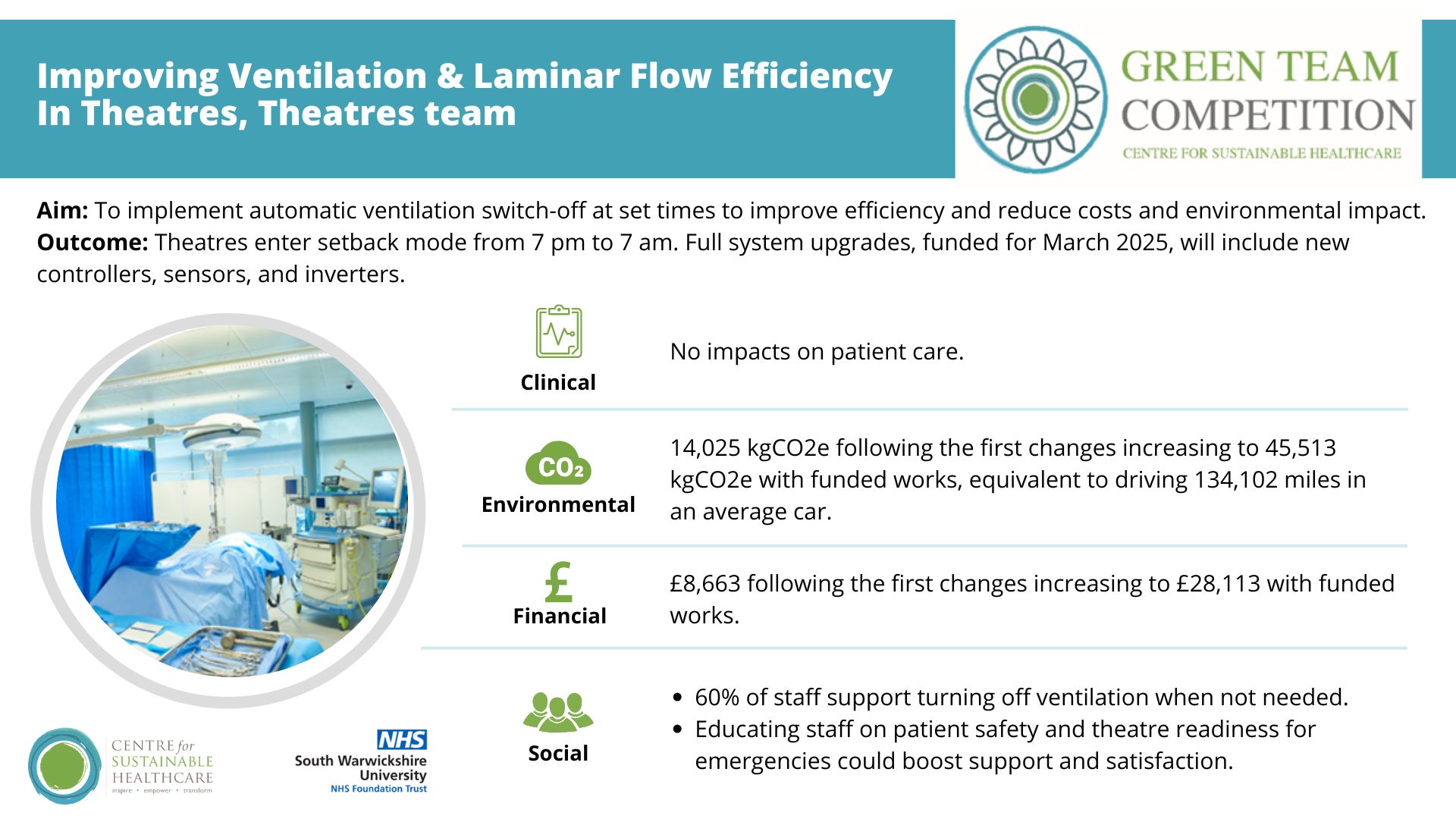Project completed as part of the 2024 Coventry and Warwickshire NHS Integrated Care System Green Team Competition.

Team:
- Rebecca Davoile, Clinical Lead Theatres
Setting / patent group: theatres
Issue:
The NHS aims to become the world’s first ‘net-zero’ health service, with energy usage accounting for 10% of its carbon footprint. Operating theatres are among the most energy-intensive areas in hospitals, consuming three to six times more energy than clinical wards. The primary cause of this high energy consumption is the ongoing operation of ventilation systems, which are often left on when theatres are not in use. This inefficiency results in significant environmental and financial implications.
The project focused on reducing unnecessary energy use in operating theatres by turning off ventilation and laminar flow systems during non-operating hours. Elective theatres typically operate during daytime hours, while emergency and trauma theatres operate around the clock. A goal was set to automatically switch off the ventilation systems between 7pm-7am for elective theatres and 8pm-7am for emergency and trauma theatres, with an override button for overnight surgeries.
However, several barriers were encountered during the project:
- The inability to fully shut off the laminar flow system, requiring system modifications with financial implications.
- Broken override buttons in some theatres and inaccessible buttons in others.
- Conventional and laminar flow systems were not linked, making full automatic shutdown unfeasible without system upgrades.
Outcomes:
The project highlighted the need for further investment in system improvements, which was supported by external funding from the NHS Energy Efficiency Fund and government Salix grants. This funding will enable the necessary technical upgrades, such as new controllers and sensors, to make the full shutdown possible. This work is taking place in March/April 2025.
Environmental and financial:
Prior to the project, the ventilation system consumed 342,988.80 kWh per year, contributing to a carbon footprint of 94,397.38 kgCO2e annually. With all changes implemented, we will save £28,113 and 45,513 kgCO2e per year.
Social:
A staff survey showed 60% of participants supported the initiative, highlighting a positive perception of reducing unnecessary energy usage. However, concerns about patient safety were addressed through consultations with Infection Prevention and Control (IPC) and the ventilation safety group, ensuring minimal risk when the ventilation system was switched off.
Further education on patient safety and system operations is anticipated to increase staff support and satisfaction.
Clinical:
No direct clinical outcomes were anticipated, as the intervention focused primarily on energy efficiency and sustainability. However, ensuring that ventilation could be restored quickly when needed mitigated any potential patient safety risks, as staff were trained to monitor and react to any changes in system functionality
Key Learning Point:
The key learning point from this project is that small changes, such as reducing unnecessary ventilation during non-usage hours, can have substantial environmental and financial benefits. Despite initial setbacks with system limitations and the need for technical upgrades, the project successfully identified key areas for improvement and secured funding for essential changes. The project also underscores the importance of staff engagement, education, and interdepartmental collaboration in implementing sustainability initiatives in healthcare settings. The expected long-term impact of this project includes substantial reductions in energy consumption, carbon emissions, and cost, contributing to the NHS’s net-zero target.
Please log in or sign up to comment.